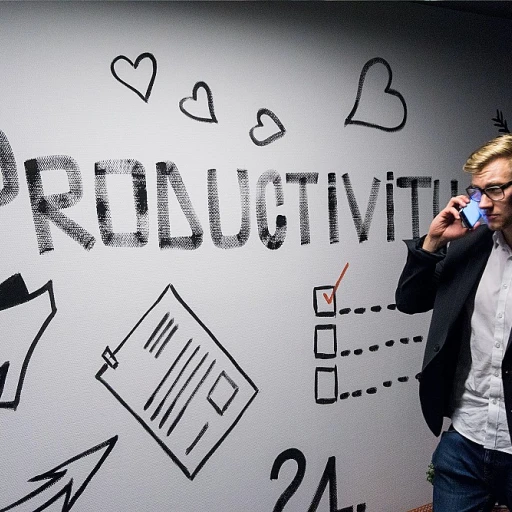Understanding the Role of CHRO in Customer Experience
The Importance of CHROs in Shaping Customer Experience
The chief human resources officer, or CHRO, isn't just the go-to for anything employee-related. They're at the heart of a company's drive to enhance customer experiences too. It might sound a bit out there, but think about it—CHROs are the ones orchestrating how employees tick, and since those employees are the ones directly interacting with customers, well, you get the picture. Let's face it, nobody wins when employees are disengaged or frustrated. It rubs off on the service, making it as appealing as a soggy sandwich. If your team isn't happy, neither are your customers. CHROs have the expertise to create environments where employees feel good, motivated, and ready to put in that extra effort to ensure a great customer journey. Ever been to a place where the workers seem genuinely pleased to be there? That's the power of a happy workforce in action. Companies like PwC know this all too well; they often stress the connection between happy employees and better business. Not everyone thinks this way, though. Some people still believe that focusing on employee happiness is a nice-to-have rather than a necessity. But it's not just fluff. We're talking real, tangible benefits to the brand experience. Now, building those robust employee experiences isn't a walk in the park. It takes investment in time, planning, and genuine care for the people who work for you. If you're wondering how to craft such an empowering employee experience strategy, here's an excellent resource that can guide you: Crafting a Winning Employee Experience Strategy. The takeaway is simple folks: keeping your team engaged and valued directly results in good customer experiences. It's a valuable win-win proposition that every business should aim for.Balancing Simplicity and Complexity in Customer Experience
Keeping It Simple, Yet Effective
When it comes to customer experience, simplicity is the name of the game. You know, nobody wants to wade through a complicated menu or deal with a convoluted service. Think about your favorite restaurant. You go there because they make ordering easy, the service is good, and the green beans are always on point. It's the same with companies. They need to keep things simple for their customers to keep them coming back for more.
Why Simplicity Matters
People are busy. They want their products and services to work without a hitch. A simple customer journey means less friction and more satisfaction. Shep Hyken, a customer service expert, often emphasizes the importance of making things easy for customers. He says that when a company simplifies its processes, it not only improves customer satisfaction but also builds a stronger brand experience.
Balancing Simplicity with Complexity
Now, let's not kid ourselves. Some businesses have complex operations, and that's okay. The trick is to make the customer experience feel simple, even if the backend is a bit of a beast. It's about creating a seamless experience where customers feel valued and understood. Companies can achieve this by investing in technology that enhances the service experience without losing the human touch.
Real-World Examples
Take PwC, for instance. They focus on keeping their services simple and effective, which has helped them build a strong reputation in the business world. By focusing on simplicity, they ensure that their customers have a great experience every time. It's not just about making things easier for customers; it's about making their lives better.
For more insights on creating a balanced approach to customer experience, check out this strategy for success.
Employee Engagement: The Foundation of Customer Satisfaction
Building Bridges Between Workforce and Customer Service
Employee engagement is not just a HR buzzword, but a real game changer when it comes to boosting customer satisfaction. When employees are genuinely committed and connected, it trickles down to creating exceptional service experiences for your customers. They become advocates for your brand, speaking volumes more than any marketing effort. Think Shep Hyken's principle of turning satisfied employees into loyal ambassadors who create great customer journey moments. In this age where customers don't hesitate to switch brands over a slight service blip, having employees who genuinely care can mean the difference between a good customer review and a complete loss of business. When your team is enthusiastic about their role and invested in the company's success, it shows. Their enthusiasm makes the entire customer journey a smooth, memorable experience which can turn even simple interactions into something great for your business.Creating an Employee Experience That Speaks to Customers
Let's talk about that extra effort your team puts in. It's not just about walking the talk; it's about living it every day. Great companies recognize that an engaged employee will likely deliver outstanding customer service. Investing in their growth, providing the right training, and fostering a culture where employees feel valued can do wonders. PwC insights have repeatedly stressed this. Their studies show the direct impact a thriving employee experience strategy can have on customer outcomes. The way we craft an employee's journey within the company sets a foundation for the customers' experiences. A happy employee offering a good customer service naturally leads to better customer interactions. It’s truly a win-win cycle that can enhance both brand and employee loyalty. The story doesn’t end here; there's a lot more to build on. Check out more about how to develop an impactful employee experience strategy to improve customer outcomes.Empowering Employees with Technology for Better Service
We can't ignore the role technology plays. In fact, it streamlines and simplifies processes, making it easier for your staff to connect with customers. When employees have access to the latest tech tools, they can handle requests swiftly, resolve issues efficiently, and keep experiences simple yet effective. Cutting-edge tools mean they spend less time grappling with systems and more time focusing on customer needs. Remember, while technology can enhance service, it's the human touch that ultimately makes the experience memorable. Balances between the two leads to a service experience that customers can't quickly forget. The right blend of tech and human interaction not only makes it better for the customer but also easier for employees to offer consistently great service. Companies need to empower their teams, giving them the freedom to tap into technology effectively while keeping things personal. By doing so, customer journeys become more fluid and aligned with the brand's mission. Embrace the potential of your workforce as the secret to good customer service and enhance customer experiences. By focusing on employee satisfaction and effective use of technology, your brand can truly stand out. It's not just about creating a service; it's about crafting memorable experiences that customers cherish.Integrating Technology with Human Touch
Blending Technology with the Human Element
In today's fast-paced business environment, integrating technology with a human touch is crucial for delivering a seamless customer experience. Companies are increasingly relying on technology to streamline processes and enhance service delivery. However, it's important to remember that the human element remains central to creating meaningful customer interactions.
Technology can simplify the customer journey by providing easy access to information and services. For instance, a well-designed online menu or self-service portal can make it simple for customers to find what they need without extra effort. However, to ensure a great customer experience, businesses must balance these tools with personalized service that makes customers feel valued.
The Role of Employees in Enhancing Customer Experiences
Employees play a pivotal role in bridging the gap between technology and customer service. They are often the face of the brand and have the power to transform a good customer interaction into a great one. Training employees to use technology effectively while maintaining a personal touch is key to improving customer satisfaction.
According to Shep Hyken, a renowned customer service expert, companies should focus on empowering employees to deliver exceptional service experiences. This involves equipping them with the right tools and knowledge to leverage technology while maintaining genuine connections with customers.
Technology as a Tool for Better Customer Insights
Technology also provides valuable insights into customer behavior and preferences, allowing companies to tailor their products and services to meet customer needs better. By analyzing data collected through various touchpoints, businesses can gain a deeper understanding of their customers' lives and create more personalized brand experiences.
For example, PwC highlights the importance of using data analytics to identify trends and enhance customer service. By understanding what customers value, companies can simplify processes and offer solutions that resonate with their audience.
Ultimately, the goal is to create a service experience that is both efficient and personal, ensuring that customers feel heard and appreciated. By integrating technology with a human touch, companies can not only improve customer satisfaction but also build lasting relationships that foster brand loyalty.
Measuring Success: Metrics and Feedback Loops
Keeping Customer Experience Simple Yet Effective
Making a customer experience simple and effective might seem tricky. But breaking it down into measurable steps is the way to go. Companies often juggle numerous metrics, yet focusing on a few that matter can transform experiences for the better.Key Metrics to Consider
- Customer Satisfaction Score (CSAT): Measure how happy customers are with your products and services. It’s simple; just ask them to rate their service experience.
- Net Promoter Score (NPS): Determines how likely customers are to recommend your company to others. It's a quick way to gauge brand loyalty.
- Customer Effort Score (CES): Ask customers how easy it was to interact with your brand. Lower effort often means better customer experiences.
Feedback Loops: The Secret to Improvement
Collecting feedback doesn't end with surveys. It demands an ongoing dialogue with customers and employees. Regularly updating your team on feedback helps them refine customer interactions. Employees are your frontline warriors; they need to feel valued to provide great customer service. A well-designed feedback loop looks like this:- Gather Data: Collect insights from customers about their experiences.
- Analyze: Break down the information to identify trends.
- Implement Changes: Use insights to refine service processes.
- Follow Up: Check back with customers after improvements to see if they notice the change.
Finding Balance: Technology Meets the Human Touch
PWC’s studies show that an integration of technology plus the human touch can create a customer experience that's hard to forget. Automating simple tasks like ordering green beans or checking a menu can improve customer satisfaction without losing the warmth of personal interaction. Investing in technology for better customer experiences doesn’t have to be flashy. Simple tools can streamline processes and enhance employee experiences, making everyone’s job easier. Shep Hyken says it best: Don't make customers feel like they're dealing with robots. Customers value interactions with real people who make an extra effort. When you merge technology with personable service, customers’ lives get better, and that fuzzy good feeling can have them coming back for more.Future Trends in Customer Experience and HR Strategy
Anticipating the Next Big Moves in Customer Experience
When it comes to keeping customers happy, companies have to think ahead. They aren't just looking at what's popular now but also considering what might be the next big thing. You see, staying in tune with future trends is more than just keeping up with competitors—it’s about setting the stage for greater brand experiences. Businesses big and small put great emphasis on making customer journeys memorable, and this involves understanding the subtle shifts in trends and preferences. By integrating innovative service experiences, businesses can create better interactions that resonate with their audience. Companies have realized that providing good customer service isn't just about solving issues but making things simple and enjoyable. Customers today crave easy solutions without the hassle, much like navigating a simple menu at their favorite diner.Predicted Transformations Awaiting Companies
- Integration of Advanced Technologies: New innovations will keep rolling out, offering tools that enhance customer interactions. From AI chatbots for instant replies to VR experiences that allow customers to feel a product's vibe, technology is set to play an ever-expanding role in the experience.
- Focus on Personalization: Shep Hyken has often remarked on the importance of treating customers like individuals. Companies will continue to refine their methods of personalization, using data insights to tailor experiences that match customer preferences, making each interaction feel custom and special.
- Employee Experience Drive: A happy employee often means a satisfied customer. Businesses will look into how they can create environments where their people thrive, purchasing efforts to improve employee experience as a foundation for creating good customer service vibes.
- Sustainability as a Selling Point: Going green isn’t just about the environment; it's becoming a key differentiator in customer choices. Brands will incorporate sustainable practices as part of their core values, not just an add-on. This change doesn’t just keep the planet happy but also appeals to eco-conscious customers.
- Feedback Loops as Growth Tools: Companies like PwC stress the importance of feedback in shaping experiences. Solid feedback structures will allow businesses to read customer sentiments like a book, acting on insights to constantly level up their service game.
- Omni-channel Flexibility: The more channels customers can use, the happier they are. Emphasizing an approach that covers everything from in-person interactions to digital platforms ensures customers’ lives run smoothly. It’s about making reaching out as easy as sipping on brewed green beans.








